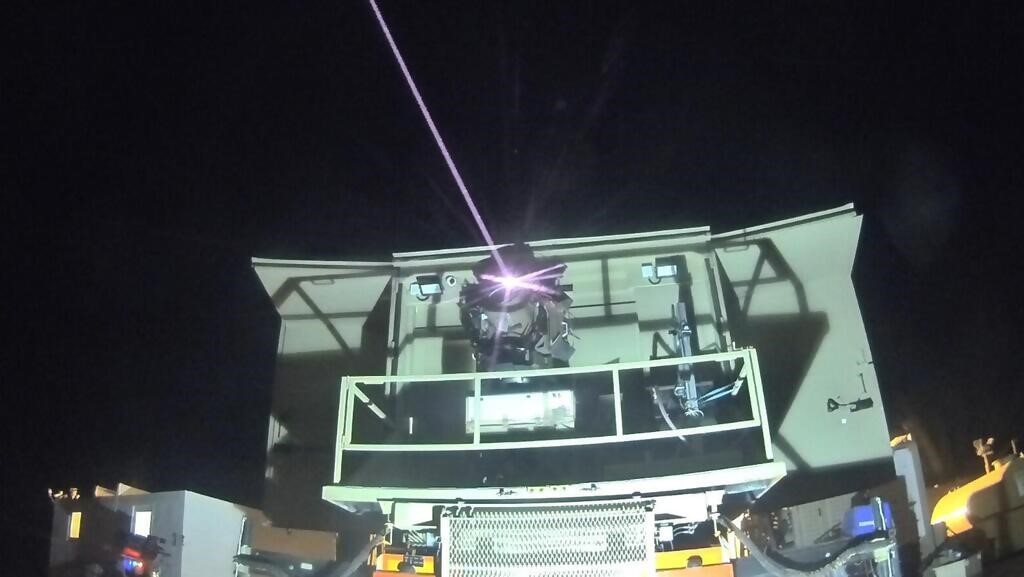Earlier this summer, Israel made military history. Not with a missile, bomb or bullet — but with a beam of light.
In a first for modern warfare, the Israel Defense Forces successfully intercepted Hezbollah drones using a high-energy laser weapon in live combat. The breakthrough weapon, developed under the Iron Beam program, quietly zapped dozens of targets out of the sky during the Iron Sword campaign, marking the first confirmed use of laser cannon technology on an active battlefield.
According to a joint statement in late May from the Israeli Ministry of Defence, the Israeli Air Force and defense contractor Rafael Advanced Defense Systems, “soldiers from the IAF Aerial Defence Array operated high-power laser system prototypes in the field, successfully intercepting scores of enemy threats.”
The technology might sound like science fiction, but officials say this laser cannon, which resembles an oversized spotlight, is anything but make-believe.
Israel’s success may signal a turning point in the race to develop laser weapons, but it’s far from the only player on the field. China was accused last month of targeting a German aircraft with a laser during an EU operation. Germany called it “entirely unacceptable,” although China denied the claim. Meanwhile, Chinese scientists are reportedly developing a microwave-based beam weapon that
resembles the Death Star and is capable of combining multiple sources into one high-powered shot.
Russia recently unveiled the “Posokh,” a laser weapon described as a “ray gun” for downing drones. Russian Airborne Forces also showcased a prototype laser rifle in March designed to protect civilian infrastructure from UAV attacks.
Laser weapons, formally known as directed energy weapons (DEWs), have been on the global radar for decades. But until now, they’ve mostly lived in research labs and defense trade shows. More than 30 countries are developing the technology — and the US military alone spends $1 billion annually on high-energy laser (HEL) research.
“The Army, Navy and Air Force have all been developing laser weapons,” says Dr. Iain Boyd, PhD, director of the Center for National Security Initiatives at the University of Colorado Boulder. “The Navy has installed HELs on several ships, the Army is using them for base defense and vehicles, and the Air Force has studied installing HELs on fighter jets.”
Are lasers poised to become the weapon of choice for modern warfare? Boyd tells The Post he expects to see “a steady increase in the use of high-energy laser weapons in the coming years. It is still relatively immature technology, but as the remaining challenges are overcome, their potential to change some aspects of warfare will be realized.”
For the moment, the Iron Beam — known in Hebrew as Magen Or, which translates to Shield of Light —shows the most promise. An offshoot of the Iron Dome, Israel’s air defense system that’s been operational since 2011, the Iron Beam was designed to “complement the Iron Dome and work alongside it, not replace it,” says military analyst Yaakov Lappin, who’s been closely following the technology for years.
But the Iron Beam promises something no other weapon can deliver: shots that cost a few dollars apiece. “It’s vastly cheaper,” Lappin says.
Israel currently spends upwards of $100,000 per Iron Dome interceptor. That’s a steep price to shoot down enemy projectiles that might cost just a few hundred dollars to build. The Iron Beam’s electric “bullets,” by contrast, are practically free.
resembles the Death Star (seen here) that is capable of combining multiple sources into one high-powered shot. Lucasfilm/Disney
“They are described as having an ‘infinite magazine,’ ” says Dr. Boyd. “Unlike guns and rocket launchers that have a finite number of munitions available, as long as a HEL has electrical power, it can keep on firing ‘bullets’ of photons.”
The US, meanwhile, has yet to deploy lasers in real-world combat despite decades of research. The Army’s Stryker-based laser, Navy’s ship-mounted HELs and Air Force programs all remain in test phases.
“I am not content with the pace,” US Navy Vice Adm. Brendan McLane said in a keynote speech at the Surface Navy Association confab in 2024. “We must deliver on the promise this technology gives us.”
America’s laser weapon dreams go back to Ronald Reagan’s 1983 “Star Wars” Strategic Defense Initiative, a $200 billion attempt to shoot down nuclear missiles with space lasers. That program fizzled out by 1993. Subsequent efforts, like the joint US-Israel “Nautilus” laser in the late ’90s, also stalled for being too bulky, weak and slow.
The pivot came with solid-state lasers which are smaller, more efficient and electric rather than chemical.
Israel had one key advantage over other nations in the race to develop lasers, says Brian Wang, a science writer and co-founder of the popular tech blog Next Big Future. “The US has spent billions over the decades, but Israel had actual fighting as a forcing factor to get this stuff working and deployed,” he explains.
The breakthrough came when Israeli engineers abandoned the old idea of firing one giant beam and instead developed a system that fires hundreds of small, coin-sized beams. These beams lock onto a single vulnerable spot, often identified via telescopic reflection, and bombard it in succession until the threat is neutralized.
The Iron Beam uses optical fiber lasers, which are essentially souped-up industrial lasers, to destroy aerial threats. “Electricity is used to excite atoms or molecules,” explains Wang. “They emit high energy photons, and all the photons are concentrated using mirrors. The laser heats a critical area — say, the fuel tank or warhead — until the missile fails.”
Lasers convert electrical energy “into a focused beam of light particles, or photons,” says Boyd. “Depending on the energy, they can cut, melt, combust or destroy a target.”
In practical terms, the Iron Beam vaporizes drones with surgical precision. But there are limits. HELs currently can’t intercept long-range ballistic missiles like the ones targeted by Israel’s Arrow 3, which shoots down threats outside the Earth’s atmosphere. For now, lasers remain short-range guardians.
Also, a weapon capable of melting metal at 2 kilometers isn’t exactly energy-efficient. A 100-kilowatt laser requires a massive power source and cooling system. The most advanced (and smallest) prototypes draw 300 kilowatts — enough to power 30 homes — and are only about 50% efficient, meaning they produce immense waste heat.
This limits where and how the weapons can be deployed. And there’s another catch.
“The effectiveness of laser beams can be diminished through interaction with a variety of environmental phenomena,” say Boyd. Rain, fog, dust and smoke can scatter laser beams, reducing their effectiveness. “The laser needs to stay locked on a target for several seconds to be effective,” he adds.
Which is why naval lasers, like those tested on the USS Preble, haven’t seen wide use. The sea is a famously unforgiving place for precision optics.
A misplaced beam can also cause serious unintended damage. As Boyd warns, there’s concern about potential collateral effects. “A laser beam reflecting off a surface could blind someone,” he says. “Or if it misses a target, it could travel hundreds of miles. There is a need to ensure no innocent party is affected.”
The UN banned laser weapons designed to blind in 1995. But with nations like Russia and Turkey reportedly fielding HELs, updated international rules may be overdue.
And then there’s the conspiracy crowd. Social media has fueled bizarre theories claiming government lasers have started wildfires in California and Hawaii, an idea experts flatly reject.
“I am very skeptical about these claims,” says Boyd. “Installing a laser of sufficient power to start a fire on a drone is not simple. For a laser to be effective, you need to have very fine pointing control to ensure that the beam stays precisely on the target.”
Achieving that during flight requires sophisticated technology, Boyd says, and there are “probably more effective ways of starting wildfires from drones than lasers.”
In a world where a $500 drone can destroy a $10 million tank, militaries are desperate for cheaper, smarter defenses. Lasers offer just that, if they can overcome their limitations.
Israel’s success may mark the beginning of a new era, one where the flash of a laser, not the roar of a missile, is what keeps the skies safe.










